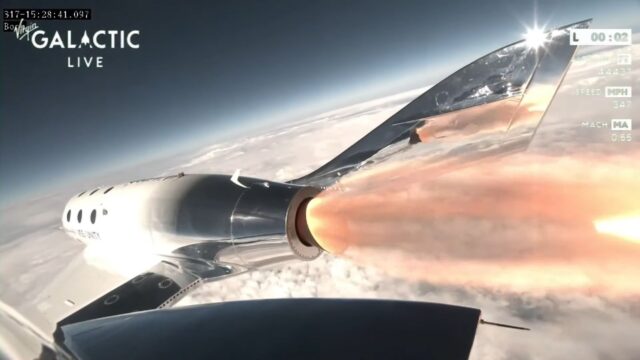Virgin Galactic launched its first tourist passengers into the weightlessness of space Thursday, the culmination of a nearly two-decade commercial pursuit, the company said.
The three passengers — Jon Goodwin, Keisha Schahaff, and her teenage daughter Anastatia Mayers — floated gravity-free through the Virgin spacecraft about 45 minutes after taking off.
“They are officially astronauts. Welcome to space,” said Virgin Galactic announcer Sirisha Bandla as the spacecraft pushed above 80 kilometers (50 miles) in altitude, the level marking the edge of space where the pull of gravity is minimal.
Live video showed the three admiring views of Earth and space through the windows.
After a few minutes in space, the craft began descending and safely landed in the US state of New Mexico, on the same runway from which it took off.
The flight was “without a doubt the most exciting day of my life, said Goodwin, 80, an adventurer who competed in the 1972 Olympic Games as a canoeist for Britain.
“The pure acceleration, Mach-3 in eight-and-a-half seconds was completely surreal,” he said.
“It was incredible and I’m still starstruck,” said Mayers, who at 18 became the youngest person ever to go into space, according to the company.
Dream of space tourism
Thursday’s long-awaited flight was the culmination of a nearly two-decade-old promise by British billionaire Richard Branson, Virgin Galactic’s founder, to bring tourists into space, giving them the chance to experience weightlessness and see Earth from afar.
The spaceflights involve a giant, twin-fuselage carrier aircraft that takes off from a runway, gains altitude, then drops a rocket-powered spaceplane that soars higher.
This mission, named Galactic 02, is the company’s second commercial flight.
The first at the end of June carried a group of senior Italian Air Force officers who had carried out several experiments on board, rather than civilians making the trip purely for pleasure.
Founded in 2004, Virgin Galactic has sold around 800 tickets for seats on future commercial flights — 600 between 2005 and 2014 for $200,000 to $250,000, and 200 since then for $450,000 each.
Goodwin reserved his seat in 2005, only to be struck with Parkinson’s Disease nine years later, dampening his hopes.
“I thought that’s the end of me going into space,” he said.
Instead, he was chosen and passed the physical tests, to become the first paying passenger for the Virgin galactic program.
“It exceeded my wildest dreams,” he said.
Schahaff and Mayers won their tickets in a charity raffle organized by Virgin Galactic. .
Schahaff is a 46-year-old health coach from Antigua and Barbuda, while her daughter studies philosophy and physics at the University of Aberdeen in Scotland.
Both said the trip was an amazing experience.
Mayers said the trip “awakened” her.
“I was shocked at the things that you feel, you are so much more connected to everything than you would expect to be,” she said.
“I definitely feel a lot more connected to Earth itself, and a lot more motivated to explore and be even more adventurous,” she said.
Branson, who made a fortune in the music industry, railways and aviation, watched the flight via video from Antigua and Barbuda, where he joined a crowd with the family of Schahaff and Mayers.
Virgin Galactic competes in the “suborbital” space tourism sector with billionaire Jeff Bezos’s company Blue Origin, which has already sent 31 people into space using a vertical lift-off rocket.
But since an accident in September 2022 during an unmanned flight, Blue Origin’s rocket has been grounded. The company promised in March to resume spaceflight soon.

COMMENTS
Please let us know if you're having issues with commenting.